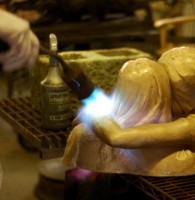Because I sculpt the entire sculpture in clay with a live model before me, I am able to capture the unique features of each model and a sense of their soul, their truth. Bronze figurative sculpture requires many steps to carefully capture its details and faithfully transform the clay original into virtually indestructible bronze. The patina finish is finally applied to enhance the contours and surface of the sculpture. Below is described the step-by-step lost wax process as outlined by Two Ravens Studio, located in Tacoma, Washington, the foundry in which I entrust my original fragile clay sculptures to perform the labor intensive process of converting my sculptures into bronze.
Mold Making
A flexible, silicone rubber is brushed onto the original artwork,building to a 3/8″ approximate thickness. The flexible mold is then covered with a rigid material called a “mother mold,” made of plaster or resin.
Wax Pattern
After the silicone mold is made, hot wax is brushed or poured into the mold to create a hollow replica of the original, with walls about 3/16 of an inch thick. The next step is wax chasing, which is the process of repairing flaws such as air bubbles or seam lines. At this stage, I take the opportunity to inspect the piece and make final adjustments, after which pouring gates are fitted. Pouring gates are a system of channels through which the molten metal passes to ensure a quick, smooth flow without chilling, and to allow gases and air to escape.
Investment
The wax pattern is then dipped into tanks of a silica-based liquid and then placed into a bed of fine sand to create a reinforced ceramic layer to create a thick shell all the way around the wax. When the investment process is finished, the shells are de-waxed in a hot kiln and then prepared for the bronze casting.

Pouring
When the investment process is finished, the shells are de-waxed in a hot kiln and then prepared for the bronze. This is the heart of the casting process! Bronze ingots are melted in a gas-fired furnace and then the molten metal is poured into the shells. As the newborn bronze cools, the shells are destroyed. Later, all remains of ceramic are removed from the bronze with hammers, chisels, and sandblasting.
Metal Finishing
Every bronze piece needs some metal work after pouring. The gates and sprues that were created in wax are now solid metal and need to be removed and recycled. Gas vents are ground off and casting flaws are welded over and repaired. Additionally, because many of my figurative sculptures must be cast in multiple pieces, they need to be assembled, welded, and tooled with hammers, grinders, sanders, and chisels. Metal-chasing hides the welds and recreates lost texture and details.
Patina

The finish on a piece is called the patina, which is a chemical treatment to the surface of the metal that affects its color and shine. Most pieces are sealed with hot wax and then protected again with a hard protective cold wax layer and then buffed out to a brilliant shine. The patina can make or break a sculpture, and I am often present at the foundry during this process to ensure that the patina accentuates the surface and contours of the piece.
Finally, the finished, extremely durable sculpture is mounted on its base and is ready for display and to be enjoyed for a lifetime by its new owner.
